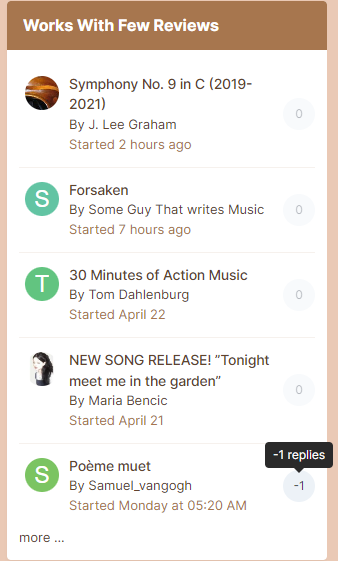Leaderboard
Popular Content
Showing content with the highest reputation on 05/08/2023 in all areas
-
Hello Guys, Here's my new piece of music, Spring Night. I'm really interested in your opinion!1 point
-
For the past 18 months I've not been active much musically. I'm back now and bursting with ideas. This piece began as a minuet but ended up an improvised fantasy. I composed the minuet ages ago and recently had access to my piano so I hit record and played it. I was playing from memory and had dumb fingers where Ive been away from the piano for so long and I forgot how to play. So it begins hesitantly and annoyingly I forgot how to play the coda of the minuet so began improvising from that point onward. I transitioned to the trio but it sounded nothing like a trio as I improvised but I liked the ideas I was coming up with and carried on. By the time the minuet returns at the end I found my confidence again. Cant believe I earned the 12 year badge, has it really been that long?! Are there many others still here who joined back then?1 point
-
NEW SONG RELEASE! Tonight meet me in the garden "A song about grace and love" Tonight meet me in the garden is a song about grace and love, and about being aware of the desperate and constant need for the Savior. ”In the middle of deep pain, sorrow and walking astray, when one’s faintly burning wick is just about to fade out, when one whom almost given up finally remember his love, the fragrance of flowers returns to life - once again.” ”Would you catch me Mashiach if I fell Would you leave the nintynine If i went astray Would you love a sinner Like me that way” (From the songlyrics) LISTEN ON YOUTUBE MUSICVIDEO https://m.youtube.com/watch?v=KAx6kCjUVRQ Download the song for FREE here: www.mariabencic.com ________________________________ Song title: Tonight meet me in the garden Song written and produced by: Maria Bencic, 2023 Vocals by: Maria Bencic LISTEN ON SOUNDCLOUD (download able)1 point
-
I has a lot of troubles uploading this lol. Im trying impressionistic instrumentación, I always loved how Debussy and Ravel uses the orchestra and I wanted to do something similar. Also, any tips for instrumentation? The piece is not complete tho1 point
-
Thanks Daniel for your review, your valuable feedback as well as your comparisons between my Caprices. Regarding M15-20 sounding louder, I guess it is a software-related problem, or an mp3 export issue. In any case I had no intention to make them louder. Regarding the tempo markings of the last three bars, the 2nd one is to ensure that the tempo does not remain the decelerated one following the ritardando (I guess I could have put "a tempo"). The one on the last bar returns the tempo to the original tempo the piece started with. As regards the accelerando and ritardando, I think the accelerando is clearly audible; the ritardando a bit less so. But these two are things that could be more pronounced in an actual performance (according to the discretion and interpretation of the performer) as opposed to a software-produced one.1 point
-
Very beautiful! Especially enjoyed the surprising key modulations near the end. The rendition works well too, with lots of reverb.1 point
-
A nice little piece, I like it. It reminds me of some classicist piano pieces. A little bit Beethoven-ish for me. Good counterpoint anyway!1 point
-
It reminds me of Debussy's style a little bit. Interesting piece of music, I think maybe it's too short, and the ending is very sudden.1 point
-
Hi Peter, Thanks for your review! For me I think I was more consciously using Bachian counterpoint (though not strict) combined with sonatina form. Beethoven influence for me is more indirect here as I never think of him in this movement. Probably this is the reason why it's my least favourite movement of the sonata. But I have to say for the overall plan of the sonata it is a good thing to have a movement less emotional since all of the other movements are emotional especially the next one. Having something light hearted in the middle isn't that bad, that's why I call it an "Intermezzo". Well after you mentioned this I find there is influence from his Eroica! I never think of the Symphomy as this movement is suppose to be a light one and certainly not comparable to the gigantic Eroica! I don't think the ending is strongly expected there with the tonic pedal preventing a real authentic cadence happening. I feel like it's more a notice of danger there with clash of G and Ab in b.141. But for me to have Db minor following Ab major is quite fluent since the Ab major is re-intrepreted as V/iv. And the coda may be out of place and unwanted in the context of this movement but certainly important for coherency as it implies the key of the next movememt which will happen haha! It may also match with the first movement, b.81 when the Ab major gets directly to the C# minor con delore section. For me I have no favourite section in the movement since it's quite boring and emotionless. Maybe the coda is a better section as I like the canonic ending. Yeah that can be lack of direction but it can be a good thing here since it does reflect what is needed. The mind is kind of fleeing aimlessly here which welcomes tragic feelings to be surfaced in the next movement. Happy you find it beautiful Peter! The next movement for me will be much more beautiful! Henry1 point
-
This is a topic too big to explore with forum posts, but it is primarily a matter of composition, and secondly a matter of sample usage. The "epic" trailer style is derided by more traditionalist orchestrators and composers precisely because originality within it is very difficult given the defining characteristics of the genre are quite rigid, and secondly: It takes the "pop song for orchestra" approach, which is not idiomatic to the ensemble and therefore winds up not sounding very orchestral at all. This manifests here (and in other tracks in the style) in the string ostinato, which is an attempt to apply the "chord progression" pop song, piano broken-chords style writing to the accompaniment/harmony in a way that dodges sample limitations. What's happening is that your accompaniment is constantly moving; jumping around in pitch against the brass line, but it is not moving homorhythmically, nor is it moving parallel, oblique or contrary to the main line. It also sounds like it is in much the same range as the brass, and thus: The brass line is muddied. The other thing is that it sounds like you have everything going full blast at all times. If everything is loud, then nothing is loud. So the dynamics need to be tweaked overall, but the melodic lines need more crescendo and decrescendo; with a sustain line, you want to ride the modwheel a fair bit. The next problem is that the theme is totally forgettable because it is exclusively legato/sustain, so it lacks a sense of pulse and the rhythmic structure of a melody is one of the most vital aspects, especially for anything jaunty or what I would call "epic". For example, if you take your keyboard and you play the C major scale descending, one note at a time, it just sounds like a boring scale. Do the same, but add the right rhythm to it and you get "Joy To The World", one of the most famous melodies out there. In short: You need to use a combination of short and long articulations, and certain notes need a clear emphasis in attack to determine the pulse and pattern clearly; something that just can't be done with exclusively-long notes. But this is an extremely common problem with modern virtual orchestration: Using different articulations to create something that sounds musical since most libraries are recorded in a very dumb manner that doesn't create much homogeneity between samples. What you will be forced to do is layer articulations like a staccato over the legato patch, but the success of this varies greatly from library to library. It took me almost 15 years to find a combination of libraries that really work well together for writing the 20th Century Styles I specialize in. If it were my piece, I'd probably do the following: • Remove the string ostinato as accompaniment and instead choose harmony according to each individual note of the theme and give this a separate rhythm that contrasts but supports the main theme and plays at a softer dynamic • Make the bassline work contrapuntally to the theme, utilizing a lot of contrary motion. A pedal tone could be tasteful in spots. • On first introduction of the theme, have the entire ensemble quieter and double the brass, either in the same section or different, but I'd utilize sixths, thirds or octaves. If it were solely brass, parallel fifths in spots could be good too. • Add more attack to the melody by layering in some short notes, maybe even doubling with pitched percussion. • Add call and response and other flourishes and orchestral flair during the last couple beats of the sustained notes in the theme to create more motion and interest • Have different parts of the theme stated by different sections and doublings, within the same phrase. I hope some of these ideas help.1 point
-
Omicronrg9, You are very kind. Thanks for riding. Hope you got on the horsey you wanted! *hehehe* 🙂 -Rick1 point
-
So, bowing works as legatos in piano but here a few sugestiones - Don't do legatos longer than 1 bar, please, just for the sake of the player - Anacrusis are done with upbow (V) - Downbows (N) sound usually stronger, importante notes should he Downbow - this is a personal opinion but I think that the rythmical group Quarter-Eighth-Eighth-Eighth should he just one bow - Everyone should (most parte of the time and in important notes) do the same bow. For examen b.9 doesnt make sense, violín I and II do diferent bows but they have the same rythm Also: - look at db registre and repertoire to see how articulations are done (the most famous piece may be the Elephant from Camille Saint-Saëns) - if you use a db, the violín registre should be higher Check: study of orchestration [Adler], section dedicated to strings1 point
-
1 point
-
I'm about to graduate from college, so I've been really focused on schoolwork. I've been working on the 4th movement of my symphony. In regards to completing compositions, I don't like spitting stuff out. I'd rather take time crafting something I can be proud of. I'm about 5 minutes into it and plan on it being roughly 15-20. The Symphony might not be completed until the end of the year, possibly sooner.1 point
-
I have no idea why I did not post this here, but I am going to start up a string of tutorials on my Youtube channel. I talk about tuplets at the very basic level, and why you may want to use them in your writing. Give the video a thumbs up, comment if you wish, and don't forget to subscribe if you want to see more of this type of content from me. Video is really long, but I break all my content up into chapters. I'm open to suggestions on how to improve my videos. For example, if there's too much dead space I can try to make my videos progress a little faster. Or if the videos are just too long, I can break them up into smaller segments. I'm literally experimenting with video length.1 point

.thumb.jpg.e5f26b712b4f9622f521b10d8a53c6d6.jpg)






